WHAT IS THE CARAT (KARAT) SYSTEM FOR GOLD JEWELLERY?
Carat (or karat) is the term used to measure the proportion of Gold in jewellery. The origin of the word ´carat´ lies in ´carob seed´, which was originally used to balance scales in Oriental bazaars. Pure Gold is designated 24 carat, and is the finest Gold found; 18 carat Gold is defined as 75% pure Gold.
WHAT IS THE DIFFERENCE BETWEEN RED, YELLOW AND WHITE GOLD?
Pure Gold is yellow in colour, but when alloyed with other metals, results in varying colours of Gold. Gold alloys are usually a mixture of Silver, copper, and zinc, where the amounts of each vary depending on the desired final colour, normally white and red Gold.
HOW DO I TAKE CARE OF MY JEWELLERY?
Although diamonds are the hardest known substance, it is possible to damage them without proper care.
Storage
It is best to store your diamond jewellery separately. We suggest individual jewellery cases, cloth pouches, or a fabric-lined jewellery box with separate dividers and compartments. Your diamonds and jewellery may become scratched or damaged when not stored properly and when allowed to contact other jewellery.
Cleaning
Lotions, soaps, powders, perfumes, and hair spray are great hindrances to beautiful and sparkling jewellery. Be sure your skin is free from these or other products prior to putting on your jewellery. From time to time you may want to clean your diamond jewellery at home. Contrary to popular belief, toothpaste is not recommended. The abrasives present in toothpaste will subtly dull the metal of your setting. It is best to prepare a solution of 1 part ammonia to 4 parts warm water. Add a small amount of a mild liquid dish washing soap. Let your jewellery soak for approximately 10 minutes. Scrub the jewellery gently with a new soft toothbrush that you will use for jewellery cleaning only. Dip the jewellery in the solution repeatedly then rinse under warm-hot tap water. Pat the jewellery dry with a lint-free cloth.
Extended
Jewellery should not be worn while participating in sporting activities or heavy labor. Diamonds may be chipped by a hard impact. Jewellery may be damaged or broken during strenuous activities. Do not allow your gold jewellery to come in contact with harsh chemicals such as chlorine and bleach. Remove your jewellery prior to entering a swimming pool or hot tub. Repeated exposure to even small amounts of these chemicals has a cumulative effect, causing gold to become brittle and susceptible to breaks and prong failure.
Inspection
Have your jewellery professionally inspected at least once a year. Your jewellery should be checked for loose stones, bent prongs, or signs of wear. It is a good idea to have your jewellery professionally cleaned at the time of inspection.
4Cs
All diamonds share certain features that allow us to compare and evaluate them. These features are called the 4Cs: Carat weight,Clarity, Color and Cut.
Bezel-setting
In this setting, the stone is secured in the mounting by a thin strip of metal surrounding the stone’s perimeter.
Blemish
A term used to describe external characteristics on the surface of a diamond, such as: nicks, scratches, polish marks, abrasions, naturals and extra facets.
Brilliance
Intensity of the internal and external reflections of white light returned to the eye through the crown of a diamond. Proportions, polish,symmetry, clarity and overall workmanship all affect a diamond’s brilliance.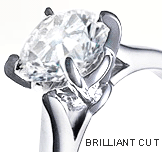
Brilliant-cut
A style of cut of a round stone, where triangular and kite-shaped facets emanate from the center of the stone to the girdle edge on both the crown and pavilion.Carat
The standard unit of weight, not size, used for gemstones. One carat is equal to 0.200 grams.Carat weight alone does not determine a diamond’s value. Two stones of equal weight can vary widely in price because of quality differences. In fact, a smaller diamond may actually be more beautiful than a larger stone with inferior cut, clarity, color or presence.

The word 'carat' comes from the carob tree whose seed was used as the standard of weighing precious stones.
Less than 5% of all the diamonds made into jewelry are larger than one carat.
Channel-setting
A setting style, where two parallel metal walls are used to hold gemstones in place, with no metal between each stone.
Chip
Shallow break on a diamond that extends from either a girdle edge or a facet junction. A chip is considered an internal clarity characteristic, and can pose a durability concern.
Clarity
A term used to describe the relative absence of inclusions and blemishes in a gemstone.A diamond’s clarity rating has a direct effect on a diamond’s beauty and price.
Virtually all diamonds have imperfections called inclusions and blemishes. A stone is said to be “flawless” if, under ten-power magnification, no external imperfections are visible and no internal flaws are visible. A truly flawless diamond is extremely rare and priced accordingly.
All gem-grade diamonds can receive a clarity rating based on an industry standard scale: FL (flawless) to I3 (heavily included).
Cloud
A type of inclusion composed of numerous pinpoints. Pervasive clouds can cause a hazy or milky appearance in a diamond.
Color
The basic hue (body color) of a diamond when brilliance and dispersion are ignored. The saturation of color is judged against a predetermined scale.The color of each diamond is determined by comparing it to authenticated “master diamonds”. Each stone is then color-graded to a precise scale from “D” (colorless) to “Z” (saturated).
Crown
The part of a diamond above the girdle plane.
Culet
Small, octagonal facet on the point of the pavilion on some brilliant-cut diamonds or a rectangular facet on the keel of some step-cut diamonds.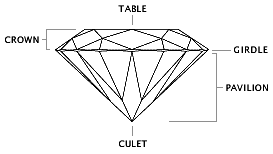
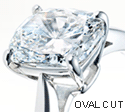
Cushion shape
Term used to describe a diamond with a rectangular or squarish girdle outline, curved sides, rounded corners and brilliant-cut facets. Another name for oval cut.Cut
Cut refers to the facet proportions on the surface of a diamond, its polish and symmetry. More than any other factor, the precision of its facets determines the beauty of the stone.There is a tradeoff between quality and size. When a stone is cut to maximize brilliance, dispersion and scintillation, it usually loses size. More of the stone must be cut away. Conversely, when cut for size, the diamond usually loses brilliance, dispersion and scintillation.
Dispersion
The breakup or separation of white light into spectral colors, each having its own wavelength and frequency. Synonymous with “fire.”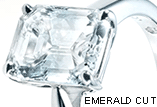
Emerald-cut
Rectangular or square step-cut stone with diagonally cut corners and two, three or four rows of facets parallel to the girdle on the crown and pavilion.Enhancement
An unnatural process that alters the appearance, particularly the colour or clarity, of a natural diamond or other gemstone. Coating, irradiation, high temperature/high pressure, fracture filling and laser drilling are all examples of enhancement. The only acceptable enhancements are cutting and polishing. Synonymous with “treatment.”
Facet
Flat, polished surface on a fashioned gemstone.
Fancy shape
Any shape other than a round-brilliant or single cut. Includes:pear,marquise, oval and heart shapes.
Feather
Any cleavage or fracture on or below the surface of a gemstone. The appearance is usually white when viewed at a right angle to the break.
Finish
Quality of a diamond’s polish, condition of its girdle, and the precision of the faceting arrangement.
Fire
The breakup or separation of white light into spectral colors, each having its own wavelength and frequency. Synonymous with “dispersion.”
Fisheye
A diamond can be fashioned with a shallow pavilion and large table, to give the impression of a much larger stone. This technique produces a dull stone, and even worse, it creates an ugly “fish eye” effect when viewed through the crown.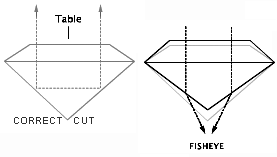
Fluorescence
Emission of visible light by a material when it is exposed to certain energy sources, such as radiation or ultraviolet light. Fluorescence only continues as long as the material is exposed to the energy source.
Four C's
The popular and overly simple four factors — cut, clarity, color and carat weight, which are commonly used to determine the value of a diamond. These factors alone are an insufficient measure of a diamond’s true quality, beauty and value.Girdle
The narrow band that circumscribes the edge of the plane intersecting the crown and pavilion of a diamond. The girdle may be polished, faceted or bruted (rough surface).
Graining
Internal or external lines commonly found on a diamond which show the growth pattern of the crystal structure. Grain lines are often the result of growth inconsistencies and cannot be removed by recutting the diamond. Significant graining can severely affect the beauty of a diamond.
Inclusion
Any internal clarity characteristic of a diamond. Large or numerous inclusions are considered flaws that seriously diminish the value of a gem.Virtually all diamonds have imperfections called inclusions and blemishes. A stone is said to be “flawless” if, under ten-power magnification, no external imperfections are visible and no internal flaws are visible. A truly flawless diamond is extremely rare and priced accordingly.
All gem-grade diamonds can receive a clarity rating based on an industry standard scale: FL (flawless) to I3 (heavily included).
Knot
A diamond crystal within another diamond crystal. Such inclusions are considered flaws and often cause a problem with the overall polish of the diamond and cannot be easily removed.
Laser Drill hole
The result of an enhancement process used to improve the appearance of a diamond with dark or black inclusions. A laser is used to drill a hole to reach the inclusion surface where it can then be bleached with acid.
Marquise shape
Elongated brilliant-cut with two curved sides and two pointed ends.Master diamonds
A set of polished diamonds of known body color and saturation to which other diamonds can be compared to assess their color grade.
Milgrain
A finishing detail on metal work that produces a beaded effect along the edge of the metal.
Modified brilliant
A type of faceting arrangement which features varying rectangular girdle outlines and cut corners with the number of facets greater or less than the standard 57 or 58 found on a round-brilliant.
Mounting
See setting.Nailhead
When the pavilion of a diamond is too deep, a darkening “nailhead” effect appears in the middle of the stone.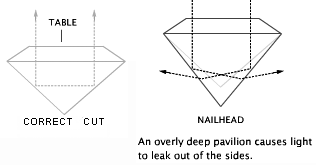
Natural
A portion of the original surface of the rough diamond which has been left on a polished diamond. This practice maximizes carat weight but may compromise beauty.Oval Shape
A brilliant-cut diamond with an elliptically shaped outline having two curved sides and two rounded ends.
Pavilion
The portion of a diamond below the girdle, including the culet.
Pear shape
A brilliant-cut diamond with a pear-shaped outline having two curved sides, one rounded end and one pointed end.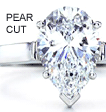
Polish
The overall condition of a facet’s surface on a fashioned diamond.
Presence
This evaluation includes precision of cut, symmetry and polish. Individually, and as a group, they influence a diamond’s beauty and overall appearance.The shape, size and angle of each individual facet is crucially important. The expert diamond cutter must follow a prescribed geometric plan to produce an “excellent” precision of cut. If the cutter fails, Tiffany will quickly find the mistake and reject the stone.
The quality of a stone’s polish directly influences a diamond’s brilliance, dispersion and scintillation.
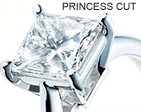
Princess Cut
Prong
Part of the metal setting designed to hold the diamond in place. Tiffany & Co. uses six prongs to hold one round-brilliant in place.
Proportion
The relative dimensions and angles of a diamond’s faceting and the relationships that exist between them.Radiant Cut
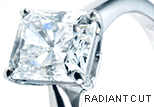
Rough Diamond
Rough diamonds are those that are mined, before they are cut and polished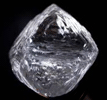
Round-brilliant
A traditional diamond shape based on the octahedron rough crystal. It has 57 or 58facets consisting of a crown, girdle and pavilion. The crown has a table, 8 kite-shaped bezel facets, 8 star facets, and 16 triangular upper-girdle facets. The girdle circumscribes the diameter and may be either faceted or bruted. The pavilion contains 8 kite-shaped main facets, and 16 triangular lower-girdle facets. It may or may not have a culet on the pavilion.
Scintillation
The flashes of reflective light emanating from a diamond’s polished facets are observed when either the diamond or light source is moved. Scintillation is often referred to as “sparkle”.
Setting
The entire metal mounting holding the polished diamond or diamonds. The design and workmanship of the setting is critical to the overall beauty of a diamond ring. Synonymous with “mounting.”
Shape
The face-up girdle outline of a polished diamond or gemstone.
Shared-setting
A setting style in which a pair of centrally positioned prongs holds two stones—one to its right and one to its left.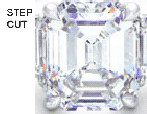
Step-cut
A cutting style in which narrow, rectangular diamond facets are arranged in rows parallel to the girdle on both the crown and pavilion.Symmetry
A term used to describe the precision and exactness of the facet placement on a polished diamond.Table
The large facet in the center of the crown of a polished diamond. On a round-brilliant-cut diamond, the table is octagonal in shape.
Trapeze
Trapezoid shaped cut diamonds, usually placed at the sides of a solitaire, or in ensembles of diamonds on a jewel.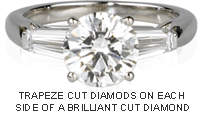
White light
Light containing a balanced mixture of all wave- lengths in the visible portion of the electromagnetic spectrum, to include: red, orange, yellow, green, blue, indigo and violet.
Worthless Carat Weight
Because carat weight is always a factor in pricing, some diamond cutters will attempt to trick casual buyers. For example, by creating an excessively thick girdle, carat weight (and price) is increased.Brilliance and beauty are, of course, noticeably impaired.FAQ
- What is the carat (Karat) System for gold jewellery?
- What is the difference between red, yello and white gold?
- How do I take care of my jewellery?
Contact Us
- UNIT 78, SDF III,
SEEPZ, SEZ, ANDHERI(E),
MUMBAI 400 096,
INDIA


